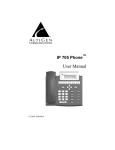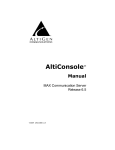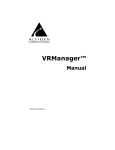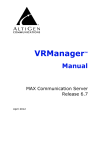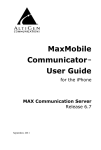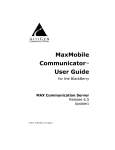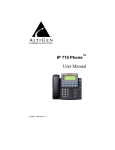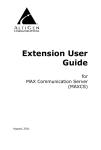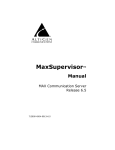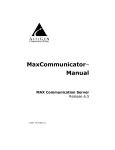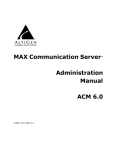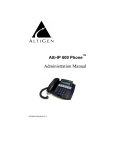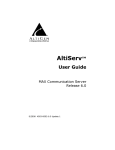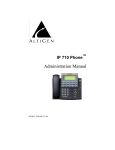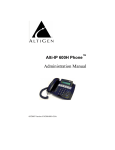Download MAXCS 8.0 IP 805 Phone User Manual
Transcript
IP 805 Phone™ User Manual 4290-2805 September 2015 WARNING! Toll fraud is committed when individuals unlawfully gain access to customer telecommunication systems. This is a criminal offense. Currently, we do not know of any telecommunications system that is immune to this type of criminal activity. AltiGen Communications, Inc., will not accept liability for any damages, including long distance charges, which result from unauthorized and/or unlawful use. Although AltiGen Communications, Inc., has designed security features into its products, it is your sole responsibility to use the security features and to establish security practices within your company, including training, security awareness, and call auditing. NOTICE While every effort has been made to ensure accuracy, AltiGen Communications, Inc., will not be liable for technical or editorial errors or omissions contained within the documentation. The information contained in this documentation is subject to change without notice. This documentation may be used only in accordance with the terms of the AltiGen Communications, Inc., License Agreement. AltiGen Communications, Inc. 679 River Oaks Parkway San Jose, CA 95134 Telephone: 888-AltiGen (258-4436) Fax: 408-597-9020 E-mail: [email protected] Web site: www.altigen.com TRADEMARKS MAX Communication Server, MaxAdministrator, MaxCommunicator, MaxAgent, MaxSupervisor, MaxInSight, MaxOutlook, MaxCall, Enterprise Manager, AltiServ, AltiLink, AltiConsole, VRPlayer, IPTalk, Alti-Mobile Extension, InTouch Dialer, AltiReport, and SuperQ are trademarks or registered trademarks of AltiGen Communications, Inc. All other brand names mentioned are trademarks or registered trademarks of their respective manufacturers. Copyright © AltiGen Communications, Inc., 2015. All rights reserved. CONTENTS WARRANTY . . . . . . . . . . . . . . . . . . . . . . . . . . . . . . . . . . . . . . . . . .1 ABOUT THIS MANUAL . . . . . . . . . . . . . . . . . . . . . . . . . . . . . . . . . . .3 CHAPTER 1 The IP 805 Phone . . . . . . . . . . . . . . . . . . . . . . . . . . . . . . . . . .5 Hardware Items in the Package . . . . . . . . . . . Supported Features . . . . . . . . . . . . . . . . . . . . Differences Between the IP 805 and the IP 705 Headset differences . . . . . . . . . . . . . . . . . . Menu differences . . . . . . . . . . . . . . . . . . . . Other differences . . . . . . . . . . . . . . . . . . . . American Disabilities Act (ADA) Compliance . . . . . . . . . . . . . . . . . . . . . . . . . . . . . . . . . . . . . . . . . . . . . . . . . . . . . . . . . . . . . . . . . . . . . . . . . . . . . . . . . . . . . . . . . . . . . . . . . . . . . . . . . . . . . . . . . . . . . . . . . . . . . . . . . . . . . . . . . . . . . . . . . . . . . . . . . . . . . .7 .7 .8 .8 .8 .8 .9 CHAPTER 2 Setting Up the IP 805 Phone . . . . . . . . . . . . . . . . . . . . . . . .11 The Phone Startup Process . . . . . . . . . . . . . . . . . . . . . . . . . . . . . . . . . . . . . 12 Miscellaneous Operation Notes . . . . . . . . . . . . . . . . . . . . . . . . . . . . . . . . . . 12 CHAPTER 3 Configuring the IP 805 Phone . . . . . . . . . . . . . . . . . . . . . . .13 Phone Settings . . . . . . . . . . . . . . . System Settings . . . . . . . . . . . . . . Network Settings . . . . . . . . . . . . . Registration from the Phone’s Menu Configuring IP Settings . . . . . . . . . Assigning a Local IP Address . . . . Assigning a TFTP Server . . . . . . . Updating Phone Firmware . . . . . . . Setting the Ring Tone . . . . . . . . . . Downloading Ring tones . . . . . . . Workgroup Status Display . . . . . . . . . . . . . . . . . . . . . . . . . . . . . . . . . . . . . . . . . . . . . . . . . . . . . . . . . . . . . . . . . . . . . . . . . . . . . . . . . . . . . . . . . . . . . . . . . . . . . . . . . . . . . . . . . . . . . . . . . . . . . . . . . . . . . . . . . . . . . . . . . . . . . . . . . . . . . . . . . . . . . . . . . . . . . . . . . . . . . . . . . . . . . . . . . . . . . . . . . . . . . . . . . . . . . . . . . . . . . . . . . . . . . . . . . . . . . . . . . . . . . . . . . . . . . . . . . . . . . . . . . . . . . . . . . . . . . . . . . . . . . . . . . . . . . . . . . . . . . . . . . . . . . . . . . . . . . . . . . . . . . . . . . . . . . . . . . 13 14 14 15 15 15 15 15 16 16 16 CHAPTER 4 User Guide . . . . . . . . . . . . . . . . . . . . . . . . . . . . . . . . . . . . . .19 The LCD Screen . . . . . . . . . . . . . . . . . . . . . . . . . . . . . . . . . . . . . . . . . . . . 19 Workgroup Status Display . . . . . . . . . . . . . . . . . . . . . . . . . . . . . . . . . . . . 19 Basic Phone Operation . . . . . . . . . . . . . . . . . . . . . . . . . . . . . . . . . . . . . . . . 20 Appendix A . . . . . . . . . . . . . . . . . . . . . . . . . . . . . . . . . . . . . .25 Specifications . . . . . . . . . . . . . . . . . Troubleshooting . . . . . . . . . . . . . . . LCD Messages . . . . . . . . . . . . . . . . Local Menu Configuration Messages IP Phone Running Messages. . . . . . IP Phone Boot Messages . . . . . . . . . . . . . . . . . . . . . . . . . . . . . . . . . . . . . . . . . . . . . . . . . . . . . . . . . . . . . . . . . . . . . . . . . . . . . . . . . . . . . . . . . . . . . . . . . . . . . . . . . . . . . . . . . . . . . . . . . . . . . . . . . . . . . . . . . . . . . . . . . . . . . . . . . . . . . . . . . . . . . . . . . . . . . . . . . . . . . . 25 25 27 27 27 28 IP 805 User Manual iii Updating Firmware . . . . . . . . . . . . . Capturing Traces . . . . . . . . . . . . . . . Generating the Log File . . . . . . . . . Generating the Packet Capture File . . . . . . . . . . . . . . . . . . . . . . . . . . . . . . . . . . . . . . . . . . . . . . . . . . . . . . . . . . . . . . . . . . . . . . . . . . . . . . . . . . . . . . . . . . . . . . . . . . . . . . . . . . . . . . . . . . . . . 28 29 30 30 Glossary . . . . . . . . . . . . . . . . . . . . . . . . . . . . . . . . . . . . . . . .31 INDEX . . . . . . . . . . . . . . . . . . . . . . . . . . . . . . . . . . . . . . . . . . . . .35 iv IP 805 User Manual Warranty What The Warranty Covers AltiGen Communications warrants its hardware products to be free from defects in material and workmanship during the warranty period. If a product proves to be defective in material or workmanship during the warranty period, AltiGen Communications will, at its sole option, repair, refund or replace the product with a like product. How Long the Warranty Is Effective All AltiGen Communications products are warranted for one (1) year for all parts from the date of the first end user purchase. Whom the Warranty Protects This warranty is valid only for the first end user purchaser. What the Warranty Does Not Cover 1. Any product on which the serial number has been defaced, modified or removed. 2. Damage, deterioration or malfunction resulting from: a) Accident, misuse, neglect, fire, water, lightning, or other acts of nature, unauthorized product modification, or failure to follow instructions supplied with the product. b) Repair or attempted repair by anyone not authorized by AltiGen Communications. c) Any damage of the product due to shipment. d) Removal or installation of the product. e) Causes external to the product, such as electric power fluctuations or failure. f) Use of supplies or parts not meeting AltiGen Communications’ specifications. g) Normal wear and tear. h) Any other cause which does not relate to a product defect. 3. Shipping, installation, set-up and removal service charges. How to Obtain Service End user customers should contact your Authorized AltiGen Partner for service. Authorized AltiGen Partners must follow the steps below for service: 1. Take or ship the product (shipment prepaid) to your AltiGen distributor or to AltiGen Communications, Inc. All materials being returned to AltiGen must have an associated RMA number. RMA numbers are issued by AltiGen Customer Service and can be obtained by calling 1-888-ALTIGEN (258-4436) or submit an online RMA request via the AltiGen Partner Resource Center, at https://partner.altigen.com. AltiGen reserves the right to refuse return of any material that does not have an RMA number. The RMA number should be clearly marked on the outside of the box in which the material is being returned. For example: Attn: RMA # 123 AltiGen Communications, Inc. 410 East Plumeria Drive San Jose, CA 95134 Upon authorization of return, AltiGen will decide whether the malfunctioning product will be repaired or replaced. 2. To obtain warranty service, you will be required to provide: a) The date and proof of purchase b) Serial number of the product c) Your name and company name IP 805 User Manual 1 d) Your shipping address e) A description of the problem 3. For additional information contact your AltiGen Partner or AltiGen Communications, Inc. Effect of State Law This warranty gives you specific legal rights, and you may also have other rights which vary from state to state. Some states do not allow limitations on implied warranties and/or do not allow the exclusion of incidental or consequential damages, so the above limitations and exclusions may not apply to you. Sales Outside the U.S.A. For AltiGen Communications products sold outside of the U.S.A., contact your AltiGen Communications partner for warranty information and services. 2 IP 805 User Manual About This Manual This manual describes how to get the IP 805 phone up and running on a voice over IP (VoIP) network. It provides information about how to set up, connect cables to, and configure an IP 805 phone. It also provides information on how to configure the network and IP settings. How to use the phone is described in Chapter 4. Related Documentation • IP 805 Quick Reference covers basic end user phone features, configuration from the IP phone, and AltiServ feature codes. • IP 805 Quick Installation Guide shows how to set up and configure your IP 805 phone. • The MAXCS Administration Manual provides detailed information on configuring AltiGen IP phones in MAXCS Administrator. IP 805 User Manual 3 4 IP 805 User Manual CHAPTER 1 The IP 805 Phone The AltiGen IP 805 phone is a business telephone that provides voice communication over an IP network. The IP 805 phone is designed for use with MaxCS. The IP 805 provides functionality similar to traditional business phones, including automatic redial, on-hook dialing, hands-free operation, 6 programmable buttons, an LCD display and headset port support. The main components of the phone are illustrated in the figures below. Figure 1. IP 805 Phone, Top View Displays features such as time, extension number, caller ID, call waiting, line/call status and call duration; displays the phone’s menu 1 LCD Screen 2 Power LED Indicates the phone’s power status Programmable keys * Six programmable buttons can be configured by the system administrator: A Busy Lamp Field (BLF) key; a Feature Code key; an Admin Defined # key; an EXT Speed Dial key; a Line Park key; a Call Record key; a User Defined # key. Call Log * Shows the caller IDs of the most recent incoming calls; dials a selected number. See page 20. Release Releases a call, exits from the menu, releases phone from an active state, rejects an incoming call. See page 22. 3 4 IP 805 User Manual 5 5 6 Mute Mutes or unmutes sound from your side of the call. Headset Enables or disables the headset. See page 20. Conference * Initiates a conference call. See page 20. Hold * Places a call on hold, indicated by a blinking light. See page 21. Flash * This button is used when transferring calls and when entering system feature codes. Transfer * Transfers calls; see page 22. Redial * Redials up to the last 16 calls and up to 32 digits. See page 21. Speaker Enables or disables the speaker. See page 22. Dial Pad Functions like a dial pad on a traditional telephone; this is also used for entering some settings that are accessed through the phone’s menu /buttons let you scroll through text on the LCD screen. Navigation buttons button selects a menu item or setting. button deletes the last digit you entered. 7 Enter – Confirms actions, accepts an incoming call. 8 Volume buttons Adjusts volume of ringer, speaker, handset and headset Displays the phone’s menu in the LCD screen. Menu 9 While you are in a menu, pressing this button moves you back to the previous menu level. DND Sets your state to Do Not Disturb. Intercom Calls an internal extension VoiceMail * Illuminates when a message is waiting; enters the voicemail system when pressed. See page 22. * Indicates a normal operating mode key feature, which is available only after registering the phone with the phone server and logged in as an extension. PC port LAN port Power Figure 2. IP 805 Phone, Port view 6 IP 805 User Manual Handset Headset The IP 805 Phone Four slots for the phone stand Figure 3. IP 805 Phone, Bottom View Hardware Items in the Package The following hardware items are included in this package: • IP 805 set and stand • Handset • Handset cord • AC adapter (Input: 100-240V; Output: DC 5V, 2A) • Power cord • Network cable Supported Features The IP 805 phone provides a wide range of call handling and dialing features directly on the phone and through the MaxCS system. • Auto Answer – You can configure your phone to ring for a specific number of seconds and then automatically connect the call. While a call is ringing, you can still manually answer it. See page 13 for details. • Busy Lamp Field (BLF) – This feature must be configured by the system administrator. BLF associates a programmable button with an extension that can be automatically dialed when selected; the button’s light indicates that the extension is busy and blinks when ringing. The BLF ring tone is played only when the phone is in idle state. It is stopped when the destination phone stops ringing or the local phone exits idle state. When multiple BLF extensions ring simultaneously, the IP phone will play the first BLF extension ringer and beep tones and ignore other BLF extensions. The BLF feature can be assigned only to internal extension numbers, not outside numbers. This feature is not available in BASIC mode. • Call Log – View a history of the most recent incoming calls (up to the last 99 calls). See page 20 for details. IP 805 User Manual 7 Differences Between the IP 805 and the IP 705 • Call Recording – Record calls by pressing a programmable key (this feature must be configured by the system administrator). You press the button to start recording, then press the button again to stop recording. There is no pause function. While a call is being recorded, the programmable key’s light is on. Recorded conversations can then be played back through voice mail or accessed at a centralized location. • Conference Calls – Initiate and add colleagues to conference calls. See page 20 for details. • Workgroup Status – View workgroup status in the LCD screen. See page 16 for details. • Hold – Place the active call on hold. See page 21 for details. • Intercom – Call an internal extension. • Line Park – The system administrator can configure a button as a Line Park button. Pressing the button will park the current call. See page 21 for details. • Programmable keys – The system administrator can offer you programmable buttons, which you can associate with a speed dial number or a feature code from the IP phone menu. • Redial – Redial a number from the last 16 numbers dialed. See page 21 for details. • Release – Hang up the active call or reject an incoming call. See page 22 for details. • Ring Tones – Select from several different ring tones; see page 13. • Transfer Calls – Transfer an active call. See page 22 for details. • Voicemail button – Opens the voicemail system. See page 22 for details. Differences Between the IP 805 and the IP 705 This section describes the primary differences between the IP 805 and other AltiGen phones. Headset differences • When using a headset with the IP 805 phone, the Headset button remains illuminated after you end the call. The next incoming call or intercom will ring into the headset instead of the speaker. • When the headset is enabled and the phone is in Idle mode, pressing the Headset button turns off the headset. • When using a headset with the IP 805 phone, no dial tone will play when the other party disconnects or when you press Release to end the call (unless #82 dial tone is disabled). • While using a headset with the IP 805 phone, if #82 (Hands Free Manual Answer Mode) is not enabled, intercom calls will go to the headset instead of to the speaker. If #82 is enabled, the intercom will ring on the headset. • For an up-to-date list of supported headsets for the IP 805, refer to AltiGen’s IP 805 web page at: http://maxcs.com/solutions/business-class-voip-phones/ip-805/ The IP 805 headset port polarity is reversed; an adapter cable (MSC-HDSETCBL-IP805) is available directly from AltiGen for headsets that are polarity-sensitive. Menu differences • To select commands in the IP805 phone's menus, press the Menu button and use the Up and Down arrow buttons to scroll through the options. Press the Menu button to return to the previous menu, press the Enter button to select a setting, and press Release to close all menus. • In the IP805 menus, the Left arrow button does not back out of menus; it allows you to edit an entry. Press the Menu key to back out of menus. Other differences • You cannot activate the IP 805 phone by entering the MaxCS IP address while the phone is in Basic mode. For instructions on activating the IP 805, refer to the Installation Guide. 8 IP 805 User Manual The IP 805 Phone • If you have not enabled #82/#81, you can press the digits to dial and press the Enter button. If you have enabled #82/#81, the IP805 behaves the same as the IP705. • Pressing **2 does not restore the default settings. To reset the IP805 to the default settings, press and hold the Enter button for 4-6 seconds. • If TLS/SRTP is enabled on an IP805 phone, the in-call PL, NL, JTF, and other counters on the phone's LCD display will remain at 0. • If you are monitoring an agent's call via MaxSupervisor using an IP805 phone, after you click Stop to stop listening to the call, you will not hear a dial tone. American Disabilities Act (ADA) Compliance The hearing aid-compatible handset on the IP 805 phone is equipped with a magnetic coupler, which meets the ADA HAC requirements. The dialing pad also complies with ADA standards. IP 805 User Manual 9 American Disabilities Act (ADA) Compliance 10 IP 805 User Manual CHAPTER 2 Setting Up the IP 805 Phone To set up the IP 805 phone, follow these instructions: 1. Gather network settings information (this information is needed to configure the IP 805): • MaxCS server IP address • IP 805 phone’s IP address This address is needed if your company does not use Dynamic Host Configuration Protocol (DHCP), which automatically assigns IP addresses to devices when they are connected to the network. The phone’s IP address can be obtained from your system administrator. 2. Connect the IP 805: a. Connect the phone to the LAN that MaxCS is on. b. Connect the handset to the handset port. c. Connect the power plug to the DC port. 3. Configure startup network settings. (To display the phone’s menu, as required below, press the Menu button on the phone. Use the/ buttons to scroll the menus and settings in the LCD screen. Press the (Enter) button to select a menu item or a setting. Press Menu again to return to the previous menu. If you are using DHCP, ensure that DHCP is enabled on the IP 805 phone: Menu > Network > Enable DHCP > Yes. (DHCP is enabled by default.) If your company does not use DHCP, disable DHCP on the IP 805 phone: Menu > Network > Enable DHCP > No. In this case, configure the following network settings on the IP 805 after setting up the phone: • Local IP address • IP subnet mask • Gateway IP address 4. Configure the MaxCS server settings (see page 15 for information about IP settings): a. Menu > SYSTEM > and press b. Select SERVER IP, and press . . c. Enter the MaxCS server IP address, using the * key to input periods, and press . 5. Activate the IP 805 extension from the IP phone: a. With the handset onhook, press #27, then press b. Enter the extension number and press . . Enter the password and press . c. The phone will attempt to register. IP 805 User Manual 11 The Phone Startup Process If the phone successfully passes through these stages, the phone shows the date, time, and extension in the LCD screen and is now in normal operating mode. 01/12 x300 The Phone Startup Process After the IP 805 has power connected to it, the phone begins its automatic booting process by cycling through these steps: 1. All LED lights will be on. 2. The LCD screen displays [ATGN BOOT] on the first line. 3. On the second line of the LCD screen, the following messages appear, in succession: —CHECK MEMORY (RAM checking state) —CHECK FW (Firmware checking state) —INIT NETWORK —LOADING FW... —LOADING NOW. —Boot Done —INITIALIZING —Version xxxx.xxxx.xxxx Miscellaneous Operation Notes • Logging in and out – When using #26 and #27 to log out / log in, the IP 805 must be onhook. Pressing the Speaker button and then using #26 or #27 will not work. • BASIC mode – If the IP 805 phone fails to register with MaxCS during startup, the phone operates in Basic mode. When in Basic mode, the IP phone’s LCD display shows (BASIC) IDLE. No MaxCS switching features are available in this operating mode. However, the phone user can enter a destination IP address followed by #, and make an outgoing call through the IP network to reach MaxCS or another IP 805 phone. Also, the IP phone can accept incoming calls originating from MaxCS or another IP 805 phone. If the IP phone’s local configuration is changed while in BASIC mode, the changes are overridden by MaxCS Administrator settings. • Incoming call takes priority – If a call comes in while you are using any phone menu or display (such as workgroup display or Call Log), the phone will exit the menu and go to the ring state. • Restoring default settings – To automatically restore the original default settings for the IP 805 phone, press and hold the OK button defaults. . You will be prompted whether to reset the phone to the factory • Rebooting the phone – To reboot the IP 805 phone, press * * 3, then press 12 IP 805 User Manual . CHAPTER 3 Configuring the IP 805 Phone Phone, system, and network settings can be configured through the IP phone’s menu. The phone can also be registered through this menu, if necessary. • To get to the menu, press the Menu button. • / buttons scroll the menus and settings in the LCD screen. • button selects a menu item or a setting. • The button selects a menu item or a setting. • Pressing the Menu button again returns you to the previous menu. • Press the Release button to exit the menu. The following tables describe each setting and the corresponding menu path. Important: Your IP 805 phone should be in normal operating mode when you configure it. If your IP phone is in BASIC mode (shown in the LCD display), your changes will be overwritten by MAXCS Administrator settings when the phone is successfully registered. Phone Settings Setting Menu Path Description Extension Number Phone Setting > Ext Number Sets the IP phone’s extension number. Extension Password Phone Setting > Ext Password Sets the IP phone’s extension password. Program Keys Phone Setting > Program Keys > Program Key [#] Sets the speed dial number or feature code for a selected key. Ring Tone Phone Setting > Ring Tones Ring Download Phone Setting > Ring Download Downloads ring tones from the server. Auto Answer Phone Setting > Auto Answer Sets whether to enable automatic answering. Phone Setting > Auto Ans Ring Sets how many seconds the phone should ring before it is automatically answered (1-20 seconds). Auto Answer Ring Auto Answer Device Sets the desired ring tone. Custom ring tones are not supported. This setting appears on the menu only when Auto Answer is set to Yes. Phone Setting > Auto Ans Dev Sets whether speaker or headset is the automatic answering device. This setting appears on the menu only when Auto Answer is set to Yes. IP 805 User Manual 13 System Settings System Settings Setting Menu Path Description MaxCS Server address System > Server IP Sets the MaxCS server’s IP address. Trunk Access Code System > Trk Access Code Sets the digit required to enable a user to return an outside call from the Call Log. Hour Offset System > Hour Offset Sets the time offset from the MaxCS server’s time. TFTP Server System > TFTP Server Sets the TFTP server IP address for updating firmware. Boot Download System > Boot Download After a firmware upgrade, this setting changes to No. This is used mainly for upgrading or troubleshooting. On the next boot, the IP phone will download the new firmware from the TFTP server, if this is set to Yes. Emergency Number System > Emergency Num Sets the IP phone’s emergency number. For the U.S., the emergency number is 911. Emergency Gateway System > Emergency GW Sets the IP phone’s emergency gateway IP address SIP Register System > Enable SIP Registration Enables SIP registration to the emergency gateway Auto-discover System > Auto Discover Enables automatic discovery of the server IP address via DHCP option 120 E911 LID System > E911 LID Sets the IP phone’s E911 Location ID Version Information System > Version Info [Read only] Displays the version number of the IP phone. Network Settings Setting Menu Path Description Enable DHCP Network > Enable DHCP Sets whether Dynamic Host Configuration Protocol (DHCP) is being used by the IP phone to retrieve a new IP address upon boot up. Local Address Network > Local Address Sets the IP phone’s local address; shows only if DHCP is disabled. Network Mask Network > Network Mask Sets the IP phone’s network mask; shows only if DHCP is disabled. Gateway Network > Gateway Sets the default Gateway IP address. NAT Address Network > NAT Address Sets the NAT server’s public IP address. Enable Vlan Network > VLan Note: When you change this setting, the phone will automatically reboot after you close the menus. Enable 802.1q Network > Enable 802.1q Define the 802.1q VLAN ID. Enable 802.1p Network > Enable 802.1p Define the 802.1p prioritization value. Enables or disables VLAN usage. 14 IP 805 User Manual Configuring the IP 805 Phone Registration from the Phone’s Menu Under normal circumstances, the IP 805 phone registers itself automatically. However, if registration failed for some reason (for example, the server was not available), registration can be started again from the IP 805 phone’s menu: 1. Press the Menu button. 2. Scroll to REGISTER. 3. Press . Configuring IP Settings An IP address is a unique logical address that identifies each host computer on a TCP/IP network. An IP address is a 32-bit number expressed as four decimal numbers from 0 to 255, separated by periods. Use these guidelines when manually entering the IP settings: • Ensure the default gateway IP address is on the same subnet as the host IP address. Check with your system administrator. • When entering IP addresses into the IP 805, use the * key to enter periods. For example, 209.120.12.8 would be input as 209*120*12*8. Assigning a Local IP Address To assign an IP address, use the following steps: 1. Ensure that DHCP is disabled. 2. Press the Menu button, scroll to Network, then press 3. Scroll to LOCAL ADDRESS, and press . . 4. Use the keys on the dial pad to enter a new IP address, using the * key to enter periods. 5. Press . Assigning a TFTP Server The default TFTP Server is set to 0.0.0.0. To assign the TFTP server, use the following steps: 1. Press the Menu button. 2. Use to select System, then press the 3. Scroll to TFTP Server, and press button. . 4. Use the keys on the dial pad to enter the new TFTP server address, using the * key to enter periods, then press . Updating Phone Firmware To update the phone firmware directly from the IP 805 phone, follow these steps: 1. Press the Menu button. 2. Use the button to scroll to System, then press 3. Scroll to TFTP Server, then press . . 4. Enter the TFTP server address, using the * key to input periods. 5. The IP 805 will download the firmware from the TFTP server on the next reboot. 6. Reboot by pressing * * 3 and . IP 805 User Manual 15 Setting the Ring Tone 7. Once the IP phone is rebooted, all LED lights come on for a brief time. 8. The LCD screen displays [BOOTING] on the first line. 9. On the second line of the LCD screen, the following messages are displayed in succession: —CHECK MEMORY (RAM checking state) —CHECK FW (Firmware checking state) —INIT NETWORK —LOADING FW... —LOADING NOW. —Boot Done —INITIALIZING —Version xxxx.xxxx.xxxx 10. You may display the version of firmware at any time: Press the Menu button, scroll to SYSTEM and press , scroll to Version Info and press . Note: An article that describes how to update IP805 firmware via TFTP can be found in the AltiGen Knowledge Base. Setting the Ring Tone To set the ring tone: 1. Press the Menu button, select PHONE SETTING, and then press 2. Scroll to RING TONES and press . . . 3. Scroll to the desired ring tone and press Downloading Ring tones When new ring tones are added to the server, they can be downloaded. To download ring tones: 1. Press the Menu button, select PHONE SETTING, and then press 2. Scroll to RING DOWNLOAD and press 3. Select YES and press . . . 4. Press the Menu button twice to close all menus. 5. Reboot the phone by pressing * * 3 and the Note: button. Custom ring tones are not supported. Distinctive Ringing Support If the Distinctive Ring options are enabled by the system administrator, you may have three different ring cadences that distinguish the types of calls: • Internal call = 1 ring • External call = 2 rings • Operator call = 3 rings Workgroup Status Display The IP phone can display workgroup status, if your system administrator configured this feature for your phone. To enable this, administrators select the Display Workgroup Status check box in the AltiGen IP Phone Configuration Page in MAXCS Administrator. 16 IP 805 User Manual Configuring the IP 805 Phone Agents press the Down Arrow button to see Workgroup status in the LCD screen (while the agent is in idle state). The first line in the LCD screen show: • QL = queue length: number of calls in queue (0~99) • QT = current longest queue time (in minutes) • WG = workgroup number (up to 4 digits) The second line in the LCD displays one of the following agent states: • LOUT - logout • NRDY - not ready • DND - do not disturb • FWD - forwarding Note: The area is blank if the agent is in any other state. Figure 4. IP 805 Workgroup Display example In the workgroup display example, QL5 indicates there are five calls in the queue, QT12 indicates that one of the calls has been queued for 12 minutes, WG2000 indicates Workgroup 2000, NRDY indicates the agent is Not Ready. When a call rings or the when you make an outgoing call, the second line of the LCD shows the Caller ID or the dialed digits display. However, when more than one call is outstanding, the first line shows the Call n/n display. If you are a member of multiple workgroups, use / to view the queue status of each workgroup. IP 805 User Manual 17 Workgroup Status Display 18 IP 805 User Manual CHAPTER 4 User Guide The LCD Screen In normal operating mode, the LCD screen displays the time and the extension number on the first line: 12:00 PM x555 MISSED xx DND Other messages you may see: • MISSED xx – Number of calls missed. • xxVM – Indicates the number of new voice messages. Appears in place of the extension number when there are voice messages. If an activity code has been set on the phone, that code is displayed in place of the extension number or voicemail count. Examples of activity codes are MEETING, AWAY, TRAVEL. DND or FWD – The extension has Do Not Disturb on, or is set to forward calls. Workgroup Status Display If your system administrator configured your phone to display workgroup status, press the Down Arrow button to show workgroup statistics. When you press the Down Arrow button (you must be in Idle state; the area will be blank if you are in any other state), the LCD screen shows the following: • QL – The number of workgroup queued calls (up to 99) • QT – The current longest queue time (in seconds) • WG – The last four digits of the workgroup number The second line in the LCD displays one of the following agent states: • • • • LOUT – Logout NRDY – Not ready DND – Do not Disturb FWD – Forwarding When a call rings the agent or when you are making an outgoing call, the second line of the LCD changes to either the Caller ID or the dialed digits display. However, when more than one call is outstanding, the first line shows the Call n/n display. IP 805 User Manual 19 Basic Phone Operation Basic Phone Operation * Indicates a normal operating mode phone feature, which is available only after registering the IP 805 with the phone server and logging in as an extension. Function Key Sequence The Call Log stores the numbers of the last 99 incoming calls. 1) With the phone onhook, press the Call Log button. Call Log* 2) Use the / buttons to scroll to the number you want. 3) Press to dial the number. Note: If 20 seconds pass without any input, the phone closes the Call Log. To initiate a conference during a call: 1) Press the Conference button (this automatically selects a new line and places the other party on hold). 2) Enter the target telephone number. 3) When the call connects, press the Conference button again OR the button to cancel the conference and return to the original party. The number of parties allowed in a conference call depends on the AltiServ system. In general, up to 6 parties are allowed. To conference an incoming call when no conference is in progress: 1) Connect to a caller. 2) Get incoming call whose Caller ID or Caller Name appears on the LCD. Call waiting tone is played. 3) Press to answer caller and place the original caller on hold. 4) Press to select the original hold call. 5) Press the Conference button to create a conference and join both callers. Conference* If a conference is already in progress, to conference an incoming call: 1) Press to answer the incoming call (all other conference members remain in conference). 2) Press and select one of the members in conference (displays “ConfHold”), then press the Conference button to join the incoming caller to the conference. The user who initiates the conference call can select another conference member’s call and drop it from the conference. To drop a conference member (available only to the user who initiated the conference call): 1) Use the / buttons to select the member to disconnect. 2) Press the button to disconnect this caller. • This feature is not available to other conference members, even when the conference initiator hangs up. Single Call Waiting, Multiple Call Waiting or Live Call Waiting must be enabled for the extension by the system administrator or in AltiView/MaxAgent in order to add incoming calls to a conference. 20 DND (Do Not Disturb) Press this button to set your state to Do not Disturb. Press it again to cancel the DND setting. Handset/ Headset/ Speaker To switch between handset, headset and speaker, you can go offhook, press the Headset button, or press the Speaker button. This button lights when the feature is enabled. IP 805 User Manual User Guide Function Key Sequence When Multiple Call Waiting is enabled at the extension, you can place multiple incoming calls on hold and retrieve them using the phone’s / buttons and the button. Pressing Hold while onhook will retrieve the last call that you placed on hold. You can place up to 9 calls on hold at a time. During a call: 1) Press the Hold button to put the current call on hold and make a new call. Hold* To retrieve a single call on hold: 1) Press the Hold button. To retrieve multiple calls on hold: 1) Use / to select a hold call to be retrieved. 2) Press . OR Press the Hold button to retrieve the last hold call. Intercom * Press Intercom to call an internal extension. A parked call line appearance can be assigned as a programmable Line Park key by the administrator. While connected to a caller, the call can be parked by pressing the Line Park button. While a call is parked at a Line Park line, the button’s light will be on. The call can be picked up by pressing the Line Park button. Line Park When configured by the administrator, the IP phone can play an audible beep or one of several different ring tones when a call is parked. 1) Press #51 and then enter the 2-digit Line Park line, or press the Line Park button (if the administrator has configured one). 2) The light on the button turns off when you pick up the parked call, when the caller hangs up, or when the call is routed to voicemail. While on a call with speaker, handset, or headset on: Mute 1) Press the Mute button. 2) To disengage mute, press the Mute button again. 1) Press the Menu button. Program Key 2) Select PHONE SETTING, then PROGRAM KEYS, then the desired program key. 3) Enter the appropriate digits for the speed dial number or feature code. Reboot 1) Press * * 3, then Redials a selected number from the last 16 calls; redials up to 32 digits. When a new call comes in, the phone will exit this menu and go to ring state. If in this menu for longer than 20 seconds without any input, the phone exits this menu. Redial Phone is onhook: 1) Press the Redial button. 2) Use / to scroll to the desired entry. ( scrolls to previous entry, scrolls to first entry.) 3) Press the Speaker button, raise the handset, or press to dial the selected number. IP 805 User Manual 21 Basic Phone Operation Function Key Sequence Deletes characters entered on the LCD. While onhook, releases the phone from an active state. Rejects an incoming call. For a connected call: • Press the Release button to hang up the call. While in a menu: Release • Press the Release button to exit the menu. For an incoming call: • Press the Release button to reject the incoming call. The ringing will stop and the call will follow the extension's Ring No Answer (RNA) handling rules. While typing in the LCD screen: • Deletes the characters you’ve entered, one at a time. Restore Default Settings 1) Press and hold the OK button ( ). 2) When prompted whether to reset the phone to the default settings, choose Yes. 1) Press the Menu button. Ring Tones 2) Select PHONE SETTING, and scroll to RING TONES. 3) Select a ring tone and press . Press the appropriate key (keys 1-6) to initiate one of the following functions that was preassigned by the system administrator: Busy Lamp Field, AltiServ Feature Code, Admin Defined #, EXT Speed Dial, Line Park, Call Record, User Defined #. To configure a programmable key with Phone Setting enabled: Programmable Key* 1) Press the Menu button, select PHONE SETTING, and press 2) Scroll to PROGRAM KEYS and press 3) Select the key to program, and press . . . 4) Enter the appropriate digits for the speed dial number or feature code, and press . To use the speakerphone: Speaker 1) Press the Speaker button. 2) To disconnect the call, press the Speaker button again. Transfers calls to another number. This button cannot be used to “Flash” after being used to transfer a call. During a call: Transfer* 1) Press the Transfer button, which places the call on hold. 2) Dial the number you want to transfer the call to. 3) Hang up if the party answers the call, or press Transfer again to complete transferring. 4) If the party refuses the call, return to the original call by pressing the button or the Flash button. The VM count that appears in the LCD screen reflects new messages (previously heard messages are not included). 1) Press the VoiceMail button. Voicemail 2) Enter the voicemail password. • The Message Waiting light blinks when a voicemail message is waiting. • The LCD screen shows the new message count (which includes only unheard messages) when onhook. 22 IP 805 User Manual User Guide Function Key Sequence To adjust volume on handset/speakerphone/headset: 1) Depending on which volume you want to adjust, take the phone offhook by lifting the handset, pressing the Speaker button, or pressing the Headset button. Volume 2) Press the Volume up or Volume down button. The device name and volume level appear in the LCD. To adjust ringer volume: 1) Leave the phone onhook. 2) Press the Volume up or Volume down button; a sample ring plays and the volume level appears in the LCD. * * Feature Codes * * 3 . . . . . . . . . . . . . . . . . . . . . . . . . . . Reboot MaxCS Feature Codes ## <pwd> . . . . . . . . . . . . . . . . . . . . . . . Log in to voicemail at your own station ### <ext> <pwd> . . . . . . . . . . . . . . . . . Log in to voicemail at another station AltiGen Voicemail System Quick Features #11 . . . . . . . . . . . . . . . . . . . . . . . . . . . . Greeting Menu #28 . . . . . . . . . . . . . . . . . . . . . . . . . . . . Password Menu Making Calls #34 . . . . . . . . . . . . . . . . . . . . . . . . . . . . Dial By Name1 #35 . . . . . . . . . . . . . . . . . . . . . . . . . . . . Virtual Log In (Station Privilege Override) #69 . . . . . . . . . . . . . . . . . . . . . . . . . . . . Dial Last Caller #77 . . . . . . . . . . . . . . . . . . . . . . . . . . . . Station Speed Dial #88 . . . . . . . . . . . . . . . . . . . . . . . . . . . . System Speed Dial #99 . . . . . . . . . . . . . . . . . . . . . . . . . . . . Last Number Redial #93 <ext> . . . . . . . . . . . . . . . . . . . . . . . Intercom Call 2 Answering Calls #29 <ext> . . . . . . . . . . . . . . . . . . . . . . . Individual Call Pickup (a specific station) #30 . . . . . . . . . . . . . . . . . . . . . . . . . . . . System Call Pickup (any station ringing) Flash button #31 . . . . . . . . . . . . . . . . . Personal Call Park #31 <ext> . . . . . . . . . . . . . . . . . . . . . . . Personal Call Park Pickup Flash button #41 . . . . . . . . . . . . . . . . . System Call Park #41 <loc. #> . . . . . . . . . . . . . . . . . . . . . System Call Park Pickup #51 <line park line> . . . . . . . . . . . . . . . Line Park Pickup #81 . . . . . . . . . . . . . . . . . . . . . . . . . . . . Hands Free Intercom Mode #82 . . . . . . . . . . . . . . . . . . . . . . . . . . . . Hands Free Manual Answer Mode Call Management #26 . . . . . . . . . . . . . . . . . . . . . . . . . . . . Station Log Out (Phone must be onhook) #27 . . . . . . . . . . . . . . . . . . . . . . . . . . . . Station Log In (Phone must be onhook) #32 <acct code> . . . . . . . . . . . . . . . . . Enter Account Code (before dialing) Flash button #32 <acct code> . . . . . . . Enter Account Code (mid-call) #33 . . . . . . . . . . . . . . . . . . . . . . . . . . . . Do Not Disturb #36 . . . . . . . . . . . . . . . . . . . . . . . . . . . . Call Forwarding #37 . . . . . . . . . . . . . . . . . . . . . . . . . . . . Remote Call Forwarding Other Features #22 . . . . . . . . . . . . . . . . . . . . . . . . . . . . Feature Status Check #25 . . . . . . . . . . . . . . . . . . . . . . . . . . . . Station Speed Dial Setup #38 . . . . . . . . . . . . . . . . . . . . . . . . . . . . Outside Call Blocking (operator only) #39 . . . . . . . . . . . . . . . . . . . . . . . . . . . . Operator Off-Line (operator only) #44 . . . . . . . . . . . . . . . . . . . . . . . . . . . . Overhead Paging #45 . . . . . . . . . . . . . . . . . . . . . . . . . . . . Overhead Paging by Trunk #46 . . . . . . . . . . . . . . . . . . . . . . . . . . . . Group Paging (for IP 805 phone users) #55 . . . . . . . . . . . . . . . . . . . . . . . . . . . . List Feature Tips #73 . . . . . . . . . . . . . . . . . . . . . . . . . . . . Silent System Call Park #90 . . . . . . . . . . . . . . . . . . . . . . . . . . . . Ready to receive workgroup calls #91 . . . . . . . . . . . . . . . . . . . . . . . . . . . . Not ready to receive workgroup calls Flash button #40 . . . . . . . . . . . . . . . . . Transfer to AltiGen Voicemail System Flash button # 15 <AA#> . . . . . . . . . . . Transfer to Auto Attendant 1 2 Feature must be enabled by system administrator. Feature available only on AltiGen IP phones. IP 805 User Manual 23 Basic Phone Operation Flash button # # <ext> . . . . . . . . . . . . Transfer to a User’s Voicemail Flash button <ext> Flash button . . . . . Consultation Press and hold OK . . . . . . . . . . Restore phone to the factory default settings Dialing an IP Number Directly from the IP 805 To dial an IP number directly from the IP 805 phone set, enter the IP address, using the * key to enter periods and followed by the # key. Note: This works only when the IP 805 is operating in Basic mode. If the IP 805 is configured for a public IP address, you can call other public IP address devices. If the IP 805 is configured for a private IP address, you can call other private IP address devices that you can “see” or that are on your subnet. 24 IP 805 User Manual Appendix A Specifications Network Protocols • H.323, SIP, RTP, RTCP, TFTP, TCP, UDP, DHCP, DNS, ARP, ICMP, Telnet Call Control Protocols • SIP Audio Standards • Codec: ITU G.711 (PCM), G.722, two low bit rate (G.723.1 and G.729A / G.729AB); G.729 preferred • Acoustic Echo cancellation supporting high-quality speakerphone • 12 standard dialing keys: 0-9, *, # Keypad Features & Handset • 11 Feature keys: Redial, Call Log, Hang-up/Release, Hold, Mute, Flash, Transfer, Conference, Speaker, Voicemail, Volume control. • 6 Function keys: can be set to N/A, Busy Lamp Field, AltiServ feature code, speed dial, directory, line park, call recording, phone setting. • Adjustable ringer/speaker/handset/headset volume control • 2 x 15 Character LCD Display LCD LED LAN • Provide features such as time, calling party name, calling party number, digits dialed, extension number, number of new voice mails, DND/FWD, missed calls, and system information. • Voice Mail, Conference, Hold, Mute, Speaker • Message waiting indicator in Voice Mail button • 2 Standard 10/100 Base-T RJ-45 Ports: One for network to phone connection, and one switch port for connection from phone to PC • Headset RJ-9 port The pin outlet for headset support is: Headset Pin 1 (Tx+), Pin 2 (Rx1), Pin 3 (Rx2), Pin 4 (Tx-) For an up-to-date list of supported headsets for the IP 805, refer to AltiGen’s IP 805 web page at: http://maxcs.com/solutions/business-class-voip-phones/ip-805/ Dimensions • (HxWxD) 8.23 x 8.74 x 1.65 in (209 x 222 x 42 mm) Power • External power, 5VDC, 1.5A Troubleshooting The following table provides help for the most common problems an end user may encounter. For IP 805 phone questions or problems not listed here, contact your AltiGen partner. Note: Some network changes, such as replacing the HMCP server or replacing the IP gateway, require the IP805 phones to be restarted. IP 805 User Manual 25 Troubleshooting Problem/Symptom Solution • Make sure that the MaxCS IP address in the IP phone is set up correctly. • Check the phone’s IP address, network mask and default gateway. MaxCS is unreachable • Make sure that you can ping the IP 805 phone’s address from MaxCS. • Make sure that the IP Phone Service is started in MaxCS. • Check the MaxCS IP address in the AltiAdmin IP Phone Configuration menu. • Check the phone’s IP address, network, default gateway settings. Image update failed. If setting Boot Download to Yes, after the phone reboots and if the setting still says Yes, the boot failed. • Check the network connection. • Check the TFTP server IP address and make sure that the TFTP server is running. • PING from the TFTP server to the IP 805. • Check network connectivity by pinging from AltiServ to the IP phone. • Check that the IP Phone Service is running. • Check if there is a duplicate IP address by unplugging the Ethernet IP phone registered then goes back to Basic mode cable on the IP phone, then pinging the phone’s IP address. • Ask the system administrator to check the extension’s IP address in MaxCS Administrator, to determine if another user is trying to log in using the same extension number. • Use #27 then Enter to log in again and see if the problem persists. • Check if DHCP is enabled. If YES, check network connection. If NO, No IP Address verify that your DHCP server is correctly configured. • Confirm that the phone’s IP address is configured correctly. One way connection Phone does not show anything on LCD display • Make sure firewall setting has all the TCP/UDP ports required by MaxCS opened. See your system administrator. • Check the power source to be sure the phone is receiving power. • A Layer 3 Managed Ethernet switch should be used, rather than a hub or non-managed switch, in the corporate LAN. Check with your system administrator. • G.711 provides better voice quality. Check with your system administrator. Poor voice quality • If VoIP is set up over WAN, priority queuing should be set on the WAN router. • System administrator should make sure WAN QoS is okay by pinging a few hundred packets from a remote site and observing packet loss and network latency. • System administrator should adjust jitter buffer to accommodate network latency. 26 IP 805 User Manual Appendix A Problem/Symptom Solution • Check that the extension number and extension password are set up properly and that the system administrator enabled the IP extension. • Ask the System administrator to confirm that the IP Phone Service is started in MaxCS. Register failed • If an analog phone or other IP phone is already logged on to the same extension, rebooting the IP 805 will not register the phone successfully. You must press #27 on the IP phone to actively log on to AltiServ. After the extension is logged on and activated, calls will be redirected to this phone. LCD Messages Local Menu Configuration Messages The following messages may appear in the LCD screen when accessing the phone’s menu: Message Explanation conf timeout! After 2 minutes inside the configuration menu, if no action is taken, the LCD will show this message and then close the menu. conf exception! During configuration, an unknown exception occurred. Saved! The changed configuration was saved. Write Fail! An error occurred when saving the changed options into flash ROM. Wrong Ext Number! The extension number that you entered is invalid. Wrong input! You entered an invalid value or string during configuration. wrong password! You entered an invalid password from the phone menu. IP Phone Running Messages The following messages may appear in the LCD screen while you use the phone: Message AW UNREACHABLE! Explanation Failed to connect to the AltiGen phone server. You are trying to register the IP phone with an invalid IP address, or the AltiGen Phone Server's IP address is invalid. The network connection has been lost in offhook or connect state. Refer to “MaxCS is unreachable” section of “Troubleshooting” on page 25. The phone is operating in Basic mode. Basic-Idle Press #27 again to reactivate. Check the IP Phone Service. Verify that the extension is configured for dynamic. DHCP FAIL! Although DHCP was enabled, the phone was not able to receive the IP address from the DHCP server. DUPLICATE IP! Another device configured with the same IP address has been detected. The phone cannot function correctly until this is corrected. IP 805 User Manual 27 Updating Firmware Message INVALID IP! INPUT AGAIN... Explanation The IP address that you entered is invalid. INVALID VAL! During registration of the IP extension, an invalid response (return value) was received from phone server. NO IP ADDR! The phone cannot attach to an IP address due to network failure. No Network! The phone has lost the Ethernet connection. REGISTER FAIL! The phone cannot register to the AltiGen phone server. REGISTER OKAY! The IP extension registered successfully. REGISTERING... You entered #27 to manually register the IP extension. REMOVE OLD EXT. When you enter #27, the extension/password configuration in the IP phone is removed. WRONG PASSWORD! The registration process failed because of an invalid extension password. IP Phone Boot Messages The following messages may appear in the LCD screen when booting the phone: Message Explanation Boot Done The phone successfully booted. CHECK FW Checking firmware. CHECK MEMORY Checking memory. INIT NETWORK Initializing network. LOAD FAILED Failure to load the image into memory. LOADING FW... Loading firmware. LOADING NOW Loading firmware. NETWORK FAILED. The network initialization process failed. TFTP FAIL! Failure downloading TFTP. UPDATE FAILED. Firmware update failed. UPDATE OK Firmware update successful. update APP(S1) When Boot Download is set to TRUE, the phone will show this message when it is rebooted. Updating Firmware Periodically, AltiGen may send out notifications of updated firmware for your phone. To update your phone’s firmware, 1. Download the file containing the updated firmware from AltiGen. Save it on your local computer. 2. On your IP 805 phone, choose Menu > Network > Local address. Write down the IP address shown. 3. In your internet browser, enter the phone’s IP address (for example, http://10.30.10.130) . The phone’s web-based configuration tool will open to the login page. 28 IP 805 User Manual Appendix A 4. On the Login page, enter the following information and then click Confirm: • User name: admin • Password: admin 5. Click the Settings tab, and then click Upgrade on the left. 6. Click Choose File and browse to the firmware file that you saved on your system in Step 1. 7. Click Upgrade. You will see a warning that the phone will be rebooted during the process; click OK. 8. Your phone will automatically reboot. To confirm that you have the correct firmware, on the phone select Menu > System > Version Information. The version number listed should match the version number indicated in your update notification from AltiGen. Capturing Traces If you have an issue with your phone, your AltiGen Technical Support representative may ask you to send various logs; these logs will help the Support organization research and resolve the problem. There are two types of logs that provide helpful information. • Log – The log provides information from the logical processing on the phone; what data the phone received, and how the phone processes it. • Pcap Trace – The packet capture contains lower level details of data coming in and out of the phone. To generate these logs, you must log into the IP 805 phone’s web-based configuration tool: 1. Establish a TCPIP connection from a computer with a browser to the PC port on the IP 805 phone. 2. On the IP 805 phone, choose Menu > Network > Local address. Write down the phone's IP address. 3. In your internet browser, enter the phone’s IP address (for example, http://10.30.10.130) . The phone’s web-based configuration tool will open to the login page. 4. On the Login page, enter the following information and then click Confirm: • User name: admin • Password: admin IP 805 User Manual 29 Capturing Traces Generating the Log File To generate a log file, perform the following steps. 1. Click the Settings tab, and then click Log on the left. 2. For the System Log Level, choose 6. This level provides the most detail. 3. Click Confirm. When you see a warning about restarting your phone, click OK. 4. To generate a log file, click the Export tab and save the trace file to your computer. Generating the Packet Capture File To generate a packet capture file, perform the following steps. 1. Click the Settings tab, and then click Upgrade on the left. 2. Beside Pcap Feature, click Start. 3. Try to recreate the problem. When you have finished, click Stop. 4. To generate the trace file, click Export and save the file to your local system. 30 IP 805 User Manual Glossary D DHCP (Dynamic Host Configuration Protocol) - a protocol that lets network administrators manage centrally and automate the assignment of Internet Protocol (IP) addresses in an organization’s network. DNS - Domain name system used to address translation to convert H.323 IDs, URLs, or e-mail IDs to IP addresses. DNS is also used to assist in locating remote gatekeepers and to reverse-map raw IP addresses to host names of administrative domains. Do Not Disturb (DND) - when this feature is selected, all incoming calls to the user’s extension are denied. If the station has system forwarding instructions, the calls will be automatically redirected to another extension, Attendant, or operator. Dynamic IP Address - An IP address that is automatically assigned to a client station in a TCP/IP network, typically by a DHCP server. Network devices that serve multiple uses, such as server and printers, are usually assigned static IP addresses. E extension number - a number that matches a station to a particular user. F Firewall - a set of related programs, located at a network gateway server, that protects the resources of a network from users of other networks. FLASH - a sudden brief signal. Activated by pressing the Flash button, or by a quick press and release of the receiver button (switch hook). H H.323 - An International Telecommunications Union (ITU-T) standard that describes packet-based video, audio and data conferencing. http or HTTP - Hypertext Transfer Protocol. The Internet protocol used to manage communications between Web clients (browsers) and servers. I IP Address - a 32-binary digit number that identifies each sender or receiver of information that is sent in packets across the Internet. J jack - the mate for a plug. Used to connect two pieces of equipment together. L Local address - an address used in a peripheral node or station in place of a network address and transformed to or from a network address for delivery purposes. M MHz - Megahertz. ms - millisecond. IP 805 User Manual 31 N network - A configuration of data processing and/or telecommunication devices and software connected for information exchange. network address - An identifier for a node, station, or unit of equipment in a network. network domain - a set of workstations and servers that share a security account manager database and can be administered as a group. A user with an account in a particular network domain can log onto and access his or her account from any system in the domain. network mask - also known as the subnet mask. network server - networking software that responds to I/O or computes requests from a client machine. Windows NT network servers can be implemented either as server processes or as drivers. O offhook - The phone’s receiver is not resting in the base. onhook - The phone’s receiver is resting in the base. P physical extension - is associated with a physical port and device. An extension is created, by default, as a physical extension (as opposed to a virtual or workgroup extension) unless there are no more physical ports available. ping (Packet InterNet Groper) - a program used to test whether a particular network destination on the Internet is online by repeatedly bouncing a signal off a specified address. port - a communication channel through which a client process communicates with a protected subsystem. protocol - A set of rules and conventions by which two computers pass messages across a network medium. Networking software generally implements multiple levels of protocols layered one on top of the other. Q queue - a collection of calls waiting to be served. Queued calls in MaxCS are handled on a first-in, first-out basis. R RJ-11 - The common telephone jack. Usually wired with four wires, the red and green signify the tip and ring circuits. RJ-45 - A jack for data cables. Usually wired with eight wires. router - a protocol-dependent device that connects subnetworks together. S server - any computer whose function in a network is to provide user access to files, printing, communication, and other services. subnet mask - the method used for splitting IP networks into a series of subgroups, or subnets. The mask is a binary pattern that is matched up with the IP address to turn part of the host ID address field into a field for subnets. System Speed Dialing - this feature allows the user to access a list of commonly called phone numbers entered into the system by the administrator. The user presses the Speed Dial button on the phone, selects a number from the list, and then dials by pressing the 32 IP 805 User Manual button. Glossary T TCP/IP - Transmission Control Protocol/Internet Protocol. A full set of protocols used on the Internet. TFTP (Trivial File Transfer Protocol) - a version of the TCP/IP FTP protocol that has no directory or password capability. transfer - this feature redirects a call to another extension or the AltiGen VoiceMail system. U UDP (User Datagram Protocol) - a communications protocol that offers a limited amount of service when messages are exchanged between computers in a network that uses the Internet Protocol. V virtual extension - an extension not associated with a physical port that allows for guest access to the AltiGen Voice Mail System features and telephone sharing environments. Users of a virtual extension have to log in before accessing the system features assigned to it. VoIP - voice over Internet Protocol (IP). The technology used to transmit voice conversations over a data network using the Internet Protocol. W workgroup - telephones arranged in groups within a particular organizational function (for example, marketing, sales, service, etc.). Each workgroup is assigned a pilot number. When the pilot number is dialed, the system scans the list of extensions comprising the workgroup and connects the call to the first available idle extension number. If no extensions are available, the call is placed in that workgroup’s queue. workgroup pilot number - an extension designated to a workgroup that is not associated with a physical port and may consist of up to 64 members. When the pilot number is dialed, the call is distributed to the workgroup members. IP 805 User Manual 33 34 IP 805 User Manual Index Index I IP 805 phone differences from IP 705 8 functions 7 hardware components 7 illustration 5, 6, 7 registering 15 specifications 25 IP address assigning 15 entering in LCD display 15 IP number, dialing 24 IP settings, configuring 15 A activating IP phone extension 11 assigning local IP addresses TFTP server 15 audio standards 25 B Boot Download 15 K 14 keys, feature C L call control protocols 25 Call log button 5 capturing traces 29 configuring from IP phone menu 13 IP settings 15 D DHCP, enabling/disabling 14 dial pad 6 dialing IP number 24 dimensions, IP 805 phone 25 distinctive ring options 16 E911 Location ID 14 emergency gateway, setting 14 emergency number, setting 14 exporting log files 29 exporting packet capture files 30 extension activating IP phone 11 password 13 extension number, setting 13 F 28 M Menu button gateway, setting IP address hardware components headset port support 25 T TFTP server assigning 15 setting IP address 14 time offset, setting 14 trace files 29, 30 traces 29 troubleshooting 25, 29 U updating firmware 28 using the phone 19 V 12 verifying phone startup process 12 version information 14 W 6 navigation buttons 6 network mask, setting 14 settings, configuring from phone 14 network protocols 25 warranty 1 how to get service 1 workgroup queue status, displaying 16 P packet capture files 30 password, setting for extensions 13 periods, entering in LCD 15 phone operation 20 phone startup, verifying 12 power, IP 805 phone 25 R G H LAN ports 25 LCD messages 27, 28 LCD screen 5, 19, 25 LED, in buttons 25 local address, setting 14 log files, exporting 29 logon, to extension in use logs 29 N E features 7 firmware, updating Flash button 6 25 service, getting 1 setting up IP 805 locally 11 setup, IP 805 11 specifications 25 startup verifying phone 12 system settings, configuring from phone 14 7 14 Redial button 6 registering IP phone 15 rejecting calls 22 Release button 5 ring tones, setting 16 S server, setting IP address 14 IP 805 User Manual 35 Index 36 IP 805 User Manual








































